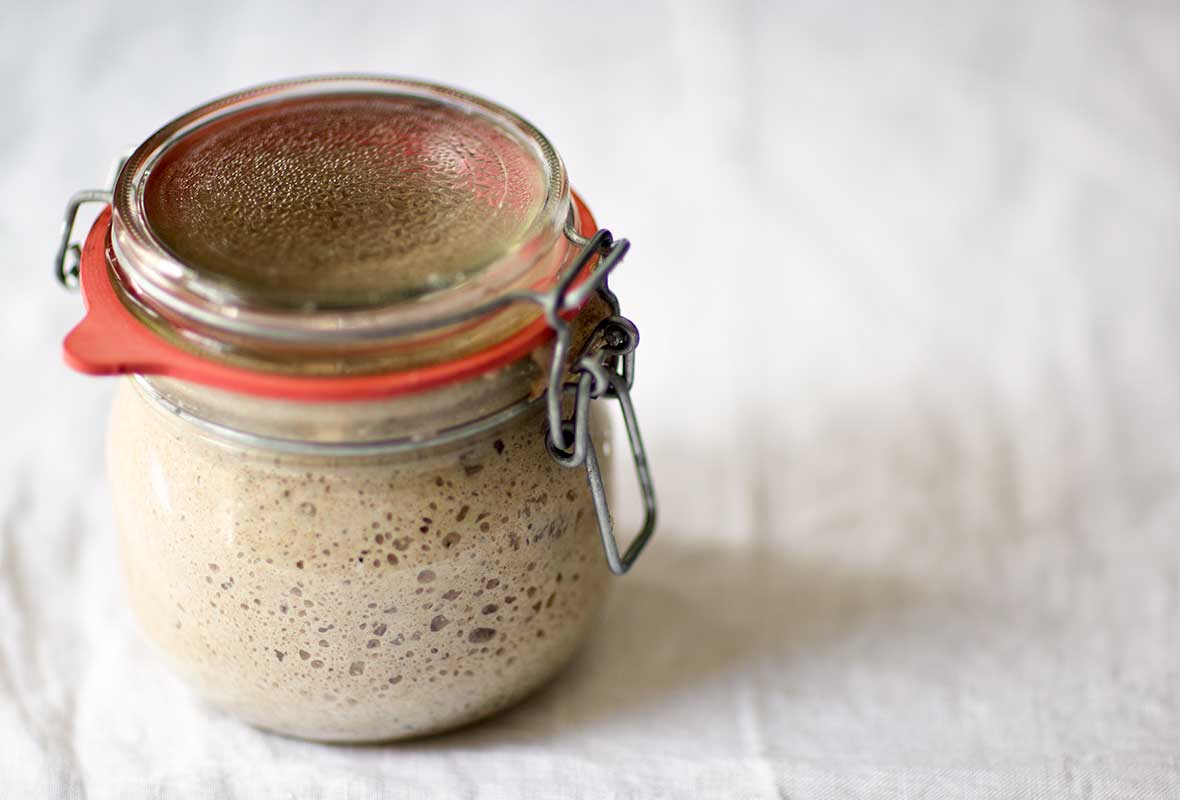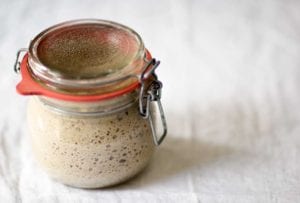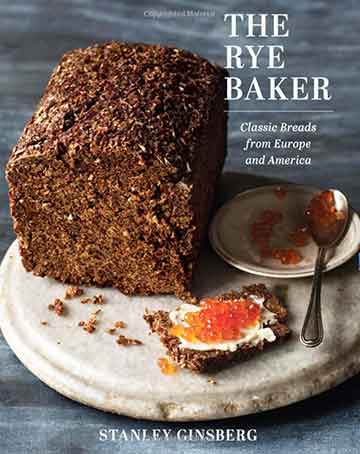
It’s not hard to make a rye sourdough starter from scratch. Some sourdough starters rely on wild yeasts that live in the air, others on acid-producing bacteria present in buttermilk, yogurt, pineapple juice, and the like, and still others start with commercial yeast or store-bought starters. Fact is, none of these additives is necessary. All it really takes to build a delicious and robust rye sour culture, or starter, is some whole-grain rye flour, water, a warm place, and patience. [Editor’s Note: And when your traditional rye sourdough starter is complete, the very first thing you’re going to want to do is use it to make this Galician rye bread.]–Stanley Ginsberg
☞ LEARN MORE, READ: HOW TO DRY SOURDOUGH STARTER

Rye Sourdough Starter
Ingredients
Day 1: Make the Rye Sourdough Starter
- 2.5 ounces whole grain rye flour, preferably organic
- 2.5 ounces warm water (105°F or 41°C)
Days 2 to 7: Refresh the Rye Sourdough Starter
- 2.5 ounces whole grain rye flour, preferably organic
- 2.5 ounces warm water (105°F or 41°C)
- 2.5 ounces Sour Starter from the preceding day
Days 8 and Beyond: Maintain the Rye Sourdough Starter
- 2.5 ounces medium or whole-grain rye flour, preferably organic
- 2.5 ounces warm water (105°F or 41°C)
- .25 ounces rye sourdough starter
Instructions
Day 1: Make the rye sourdough starter
- Start with equal amounts of organic rye flour and water by weight. Dump them in a nonreactive (glass, porcelain, stainless-steel, plastic) container, mix by hand into a stiff paste, cover, and let stand at room temperature (68 to 72°F or 20 to 22°C) for 24 hours.
☞ TESTER TIP: Occasionally the yeast normally present in whole grains fail to establish itself in a new culture; if, after 3 or 4 days, the culture darkens, develops a mold, or smells bad, dump the whole batch and start over. After a week, the culture, or sourdough starter, will be ready to use or to be stored refrigerated in an airtight container for a couple days. [Editor's Note: If storing the sourdough starter for more than a couple days, you'll need to maintain it, which we explain how to do just below.]
Days 2 to 7: Refresh the rye sourdough starter
- The next day, discard all but 2 1/2 ounces (70 grams) of the culture and mix the remainder with the refresh ingredients, cover, and let stand. Repeat each day, discarding all but 2 1/2 ounces (70 grams) of the preceding day’s culture.
☞ TESTER TIP: The most important point to remember at the early stages is to feed the sourdough starter daily. Even when it shows no apparent fermentation, the yeast is busy multiplying and consuming nutrients at a very high rate. By the second or third day, it will swell, show bubbles, and give off a clean sour smell. Over the next few days the activity will become more and more vigorous and the smell more intense.
Days 8 and Beyond: Maintain the rye sourdough starter
- In a perfect world—or in a working bakery—sourdough starters are refreshed daily. That said, daily feedings demand both a degree of dedication and abundant flour supplies that are impractical for all but the most committed home bakers. You can get by refreshing your starter every 36 hours or so.
- Mix the rye flour, water, and rye sourdough starter by hand until incorporated. Cover and ferment at room temperature (68 to 72°F or 20 to 22°C) overnight or for 10 to 12 hours. The sponge will be very bubbly, have a clean sour smell, and will have tripled in volume. Store refrigerated in an airtight container and it will last indefinitely.

Nutrition
Nutrition information is automatically calculated, so should only be used as an approximation.
Recipe Testers’ Reviews
The rye starter was easy to make and quick. It took about 5 minutes each of the 7 days. Mine smelled great and seemed consistent after the week of feedings. I switched to the refresh amounts after that and it stayed nice and healthy.
During the buildup, you end up tossing about 2/3 of it away. I definitely recommend a scale versus just using volume measurements.










Have you any other rye sourdough bread recipes that use more rye flour? I like the Galician Rye but I’m trying to cut down on wheat. I know rye doesn’t have much gluten but I’ve had scalded rye breads that I loved and was wondering how to expand my sourdough rye starter usage.
Hi Mary. Thanks so much for asking. We do have a milk rye bread recipe by the same author on the site, and it uses more rye flour. You can find the recipe here. Let us know if you try it and how it turns out for you.
Thanks!! Printing it now. I’ll post a picture when I’ve made it(still using up the latest Galician Rye loaf).
Wonderful! I can’t wait to see how it turns out.
Hello all. I built my rye starter in March and it took two tries because our house was too cool. The second time, I nestled my starter in a kitchen towel above (not in) a crock pot set to warm. That did the trick. This time of year, our house is plenty warm — starters seem very happy at about 75 degrees. I don’t do all that discarding. I just keep a small amount — maybe 2-3 tablespoons. A couple days before I’m ready to bake, I mix in the amount I will use. For example, if I need 100 g of starter, I mix in 50 g flour and 50 g water. I let it sit on the counter during the day and it gets really happy, usually tripling or at least doubling in bulk. Then, I use the 100 g and put the rest back into the jar for next time. I bake about every 5 -7 days, so it keeps my starter fresh and happy. I never discard and all that and it seems to work just great.
Great! Thanks for taking the time to let us know, Eric.
I’ve Just started to make this and the starter is a thick sticky paste is this the way it is supposed to be as the last time i made a sourdough starter it was wet. I am using organic rye flour.
Thank You
Joe
That looks about right, Joe. As it grows and feeds it should loosen up a bit, but it is a very stiff paste to begin with.
Thank you Angie was also concerned it may have been too cold as it dropped to 2 deg c last night. Have it out in the sun so will bring it back in. Cheers
Joe
You’re welcome, Joe! I’m in Canada, so even though we are in summer now, my kitchen is often very cold too and I’ve managed to maintain a starter. They’re more resilient than we give them credit for!
I think my problem maybe its in a bowl rather then a jar so will keep an eye on it for a few more days and see.
It should be ok in a bowl, Joe. It may take a few days longer than expected if your kitchen is on the cooler side.
Thank You Angie. Just home from work will feed and put into a jar with a lid and keep in the oven for a change with the lid open. Appreciate your feedback. Cheers.
You’re welcome, Joe! Keep us posted.
Hi Guys. Sorry for the slow reply finally have my rye starter working really well in and out of the fridge. 🙂 Baking a rye and white every two weeks. My wife says the rye is just like she use to buy in Germany. Happy Days. 🙂
Bread.
Joe, they’re gorgeous!
Fantastic, Joe! Thanks so much for taking the time to let us know.